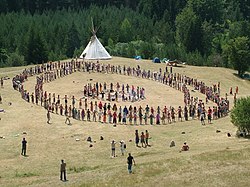
Back رؤية عن بعد Arabic Visió remota Catalan Fernwahrnehmung German Visión remota Spanish Kaugtunnetus ET دوربینی روحی FA Vision à distance French Gledanje na daljinu Croatian Fjarskoðun IS Visione remota Italian
| Claims | The alleged paranormal ability to perceive a remote or hidden subject without support of the senses.[1] |
|---|---|
| Year proposed | 1970 |
| Original proponents | Russell Targ and Harold Puthoff |
| Subsequent proponents | Ingo Swann, Joseph McMoneagle, Courtney Brown |
| New Age beliefs |
|---|
 |
| Concepts |
| Spiritual practices |
| Doctrines |
| Part of a series on the |
| Paranormal |
|---|
Remote viewing (RV) is the practice of seeking impressions about a distant or unseen subject, purportedly sensing with the mind.[1] Typically a remote viewer is expected to give information about an object, event, person or location that is hidden from physical view and separated at some distance.[2] Physicists Russell Targ and Harold Puthoff, parapsychology researchers at Stanford Research Institute (SRI), are generally credited with coining the term "remote viewing" to distinguish it from the closely related concept of clairvoyance.[3][4] According to Targ, the term was first suggested by Ingo Swann in December 1971 during an experiment at the American Society for Psychical Research in New York City.[5]
Remote viewing experiments have historically been criticized for lack of proper controls and repeatability. There is no scientific evidence that remote viewing exists, and the topic of remote viewing is generally regarded as pseudoscience.[6][7][8][9][10][11]
The idea of remote viewing received renewed attention in the 1990s upon the declassification of documents related to the Stargate Project, a $20 million research program sponsored by the U.S. government that attempted to determine potential military applications of psychic phenomena. The program ran from 1975 to 1995, and ended after evaluators reached the conclusion that remote viewers consistently failed to produce any actionable intelligence information.[n 1][12]
- ^ a b Blom, Jan. (2009). A Dictionary of Hallucinations. Springer. p. 451. ISBN 978-1441912220
- ^ Zusne, Leonard; Jones, Warren (1989). Anomalistic psychology: a study of magical thinking. Lawrence Erlbaum Associates. p. 167. ISBN 0805805087.
- ^ Kendrick Frazier. Science Confronts the Paranormal. Prometheus Books, Publishers; ISBN 978-1615926190. pp. 94–.
- ^ Joe Nickell (March 2001), "Remotely Viewed? The Charlie Jordan Case", Skeptical Inquirer
- ^ Targ, Russell (2012). The Reality of ESP: A Physicist's Proof of Psychic Abilities. Quest Books. pp. 4, 14, 23. ISBN 978-0835608848.
- ^ Alcock, James. (1981). Parapsychology-Science Or Magic?: A Psychological Perspective. Pergamon Press. pp. 164–179. ISBN 978-0080257730
- ^ Gilovich, Thomas (1993). How We Know What Isn't So: Fallibility of Human Reason in Everyday Life. Free Press. pp. 166–173. ISBN 978-0029117064
- ^ Marks, David; Kammann, Richard. (2000). The Psychology of the Psychic. Prometheus Books. ISBN 1573927988
- ^ Wiseman, R; Milton, J (1999). "Experiment One of the SAIC Remote Viewing Program: A critical reevaluation" (PDF). Journal of Parapsychology. 62 (4): 297–308. Retrieved 2008-06-26.* Obtained from listing of research papers on Wiseman's website
- ^ Gardner, Martin (2000). Did Adam and Eve Have Navels?: Debunking Pseudoscience. New York: W.W. Norton. pp. 60–67. ISBN 978-0393322385.
- ^ Hines, Terence (2003). Pseudoscience and the Paranormal. Prometheus Books. p. 136. ISBN 1573929794.
- ^ Cite error: The named reference
Timewas invoked but never defined (see the help page).
Cite error: There are <ref group=n> tags on this page, but the references will not show without a {{reflist|group=n}} template (see the help page).